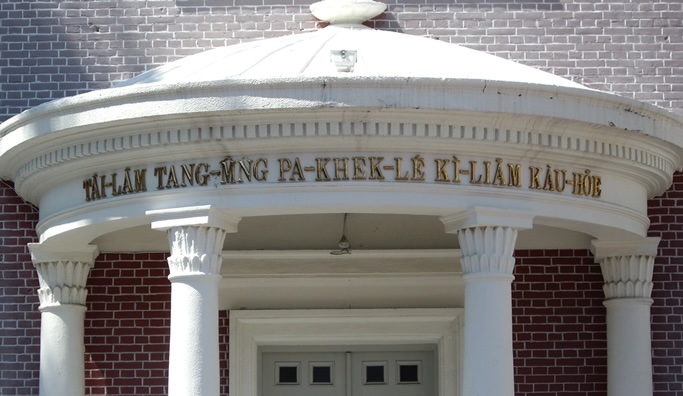Tâigael, part 2
« previous post | next post »
[This is a guest post by Chau Wu]
The Presbyterian Church in Taiwan (TPC) was first planted by British missionaries in Tainan, which later expanded to all southern parts of Taiwan, constituting the present Southern Synod of TPC. The most important pioneer among them was the Scottish missionary Rev. Thomas Barclay who worked in Taiwan-Fu (the present Tainan). He was born in Glasgow, and matriculated at the University of Glasgow. While there, he studied under Sir William Thomson, later Lord Kelvin [according to Wikipedia]. The celebrated Lord Kelvin reminds me of the absolute zero degree in physical chemistry and the electric cable equation as the underpinning of the Transatlantic cable as well as the conduction of electric impulses along nerve fibers.
The majority of Taiwanese Christians are Presbyterian. Those who are aware of the church history always associate the solid establishment of TPC with Barclay, and his name shows up in Barclay Memorial Park and Barclay Memorial Church in Tainan City. The following picture shows the church name on the lintel above the door of the church in POJ: Tâi-Lâm Tang-M̂ng Pa-Khek-Lé Kì-Liām Kàu-Hōe (Tainan East Gate Barclay Memorial Church). You see there are no Sinographs such as the expected 台南東門巴克禮紀念教會 on it! Only the Romanized Taiwanese script. Since Barclay was a Scot, I would say this title on the church lintel may qualify as a good example of Tâigael.
(From Wikipedia)
Interestingly, the present Northern Synod of TPC had its beginning in 60 churches established by Rev. George Mackay, a Scottish-Canadian who graduated with a theological degree from Princeton Theological Seminary and received postgraduate training in theology at Edinburgh University. His parents, George Mackay and Helen Sutherland, emigrated from Sutherlandshire of Scotland. So, here we have another case of Tâigael linkage, albeit by a generation removed from Scotland. On a personal note, my grandfather was the second earliest of his many students and was among the first 5 Taiwanese of northern Taiwan to receive baptism from him at Tamsui. The Presbyterian church at Tamsui has a marble plaque recording this event.
Perhaps to those of us among Language Log readers who are interested in Taiwanese linguistics, one of the most important figures is the Scottish missionary Rev. William Campbell.
William Campbell (Chinese: 甘為霖; Pe̍h-ōe-jī: Kam Ûi-lîm) (1841–1921) was a Scottish Presbyterian missionary to Formosa (Qing Taiwan). He wrote extensively on topics related to Taiwan and was also responsible for founding the island's first school for the blind.[3] Interested in the early history of the island (particularly the Dutch era), his knowledge of the time was such that he was called "without doubt the greatest authority on this subject living".[4] He was probably the first European to see Sun-Moon Lake,[5] which he named Lake Candidius in honour of the seventeenth century Dutch missionary George Candidius.
…
Campbell arrived in Qing-era Taiwan in 1871 to begin his mission in southern Taiwan, being stationed in Taiwan-fu, the capital of Taiwan Prefecture (modern-day Tainan) and serving both Han Chinese and Taiwanese aborigines in the area.[6] He was a contemporary of Thomas Barclay, James Laidlaw Maxwell and George Leslie Mackay, who were all engaged in missionary work in Taiwan.
(source)
A major contribution of his, “A Dictionary of the Amoy Vernacular Spoken throughout the Prefectures of Chin-chiu, Chiang-chiu and Formosa (Taiwan) 廈門音新字典” stands out as the Tâigael example par excellence. This dictionary, compiled by a Scot, is ironically for me a Taiwanese, the go-to handbook for studying Taiwanese historical linguistics.
Tâigael works wonders in the spread of gospel to Taiwan.
Selected readings
- "Pinyin: the proof is in the pudding" (7/8/25)
- "The politico-cultural implications of Taiwanese romanization" (3/12/25) — lengthy, essential bibliography of posts on Hoklo, writing with POJ, etc.
- "Confessions of an Ex-Hokkien Creationist" (9/20/16) — highlly informative about POJ, Hokkien, etc.
- "Tâigael" (7/4/25)

J.W. Brewer said,
July 12, 2025 @ 8:23 am
The Rev'd Mr. Barclay was from Glasgow, where the dominant local language had already shifted from Gaelic to Scots by circa 1500, so it's not particularly likely he would have had any fluency in the language. On the other hand, it is plausible although not certain that the parents of the Rev'd Mr. Mackay would have been L1 Gaelic speakers, because the language was still doing well in Sutherland around the time they would have been born. Whether Gaelic was typically passed on to the new generation in the particular part of Canada where they settled I don't know – if so it did not persist as long as it did in parts of Nova Scotia.